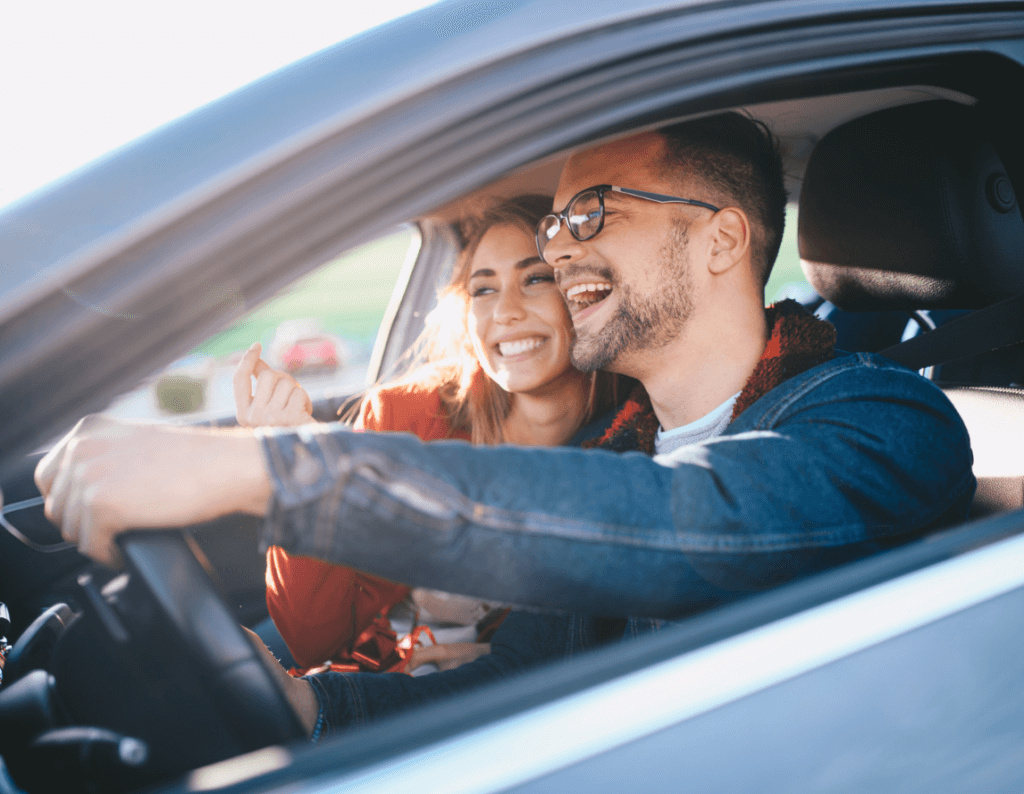There are an infinite number of distractions drivers must tune out when operating their vehicles. The most common types of distractions can be divided into three categories: visual, manual, and cognitive. Understanding the three main types of distracted driving can help you learn how to avoid them and keep your focus completely on the road ahead.
1. Visual Distractions
A visual distraction is one that takes a driver’s eyes off the road. When most people think of distracted driving, they immediately think of visual distractions because the world around us is full of visual distractions. There are billboards, roadside attractions, sweeping views, and wildlife on Texas roadways in rural areas.
Inside the car, there are distractions such as pets or children who need assistance, but as technology has advanced, we are more often keeping our eyes on devices instead of the road. Cell phones, GPS systems, complicated entertainment centers, and TV screens in cars have increased the possibility of being visually distracted while driving.
Visual distractions are extremely dangerous. If a driver takes their eyes off the road for even a few seconds to read a text while going 55 mph, they can travel the length of a football field before they look up again.
Texting drivers can cause rear-end accidents and highly dangerous T-bone accidents. Not only is holding the phone to talk or text someone dangerous, but it’s also been against the law in Texas since 2017, carrying a $200 fine.
2. Manual Distractions
A manual distraction is one that physically takes a driver’s hands off of the steering wheel for any amount of time. This immediately reduces the amount of control a driver has over their vehicle, as it takes both hands to maneuver a car on the road safely. Some examples of manual distractions include:
- Eating
- Drinking
- Smoking or vaping
- Adjusting the temperature in the vehicle
- Changing radio stations or choosing music on a phone
- Retrieving an item from a purse or bag
More people indulge in manual distractions than they realize. Manual distractions considerably reduce a driver’s reaction time when they need to make a sudden change, including turning the wheel quickly. According to the Texas Department of Transportation (TxDOT), one in six car accidents in 2022 was the result of a distracted driver.
3. Cognitive Distractions
A cognitive distraction is anything that takes the driver’s mind off of driving. These distractions are the hardest to detect as you are not likely to realize you are distracted until you snap out of it. In the most extreme cases, this only happens when you are running off the shoulder or about to be in an auto accident.
A driver may appear to be doing everything right, but they have lost focus and are not reacting to changes on the road.
It’s easy to get lost in an engrossing podcast or carried away while listening to your favorite music. If you’ve recently been in an emotionally stressful situation, such as a fight with a loved one or a problem at work, your mind may be elsewhere when driving. Even talking to someone in the car or on a hands-free phone call takes your focus off the job of driving.
Other critical factors that can affect your ability to pay attention are when you are sleepy or physically tired. Studies show that being tired while driving is almost as risky as driving while under the influence of alcohol. Of course, you also shouldn’t drink or take certain prescription drugs before operating a vehicle. Your reaction time can be substantially delayed, meaning you’re less able to recognize a problem before you crash.
Preventing Visual, Manual, and Cognitive Distractions
Fortunately, there are a number of actions you can take to avoid these types of distractions and reduce your chance of getting in a car accident. Before you start your trip, do the following:
- Set your GPS directions and choose your music
- Adjust the mirrors, seat, and temperature
- Ensure your children and pets are secure in their seats or harnesses
- Have a snack or drink for yourself that is ready and easy to reach
- Wear your prescription glasses or sunglasses, or have them close at hand
- Set your phone to “Do Not Disturb” or connect it to your heads-up car display so you don’t have to touch the phone to see texts or calls
- Alternatively, set up an autoreply to messages to inform people you’re driving and will get back to them later
- Do not take medications that make you sleepy or disoriented
- Avoid drinking alcohol
On the Road
Once you are underway, keep an eye on the vehicles around you. Watch out for motorcycles since they are small and easy to overlook. Be cautious when entering or exiting the road or highway, and allow room for others who are merging into traffic. Keep both hands on the wheel and keep checking your mirrors, especially before changing lanes.
Avoid engaging in emotional or heated discussions with passengers or during a phone call. If things escalate, find a safe spot to pull over and continue or end the conversation. Also, do this if you see a text you urgently need to answer. On a longer drive, take regular breaks for short walks, refreshments, and restrooms. Stopping also gives everyone in the car a mental change of pace.
If you have a long trip, perhaps from Houston to El Paso, make sure you consider stopping for the night to break up the trip and keep yourself mentally sharp. Most Texans hardly blink at the thought of a nine-hour drive to visit the western part of the state, but it’s better to be safe than to take the risk of getting in a crash.
Avoiding Other Drivers Who May Be Distracted
Of course, even if you do everything right and are careful, you can’t always eliminate the danger of others who are more reckless. If you see another vehicle weaving, speeding, or failing to maintain their lane, it’s wise to give them space. Try to stay back or change lanes to give you some room in case something unexpected happens.
If you can pass them safely and without exceeding the speed limit, do so and leave them behind. While they may not be distracted, if their driving is erratic, it’s safe to assume they could be a hazard. If you witness them engaging in a distraction, such as texting or holding their phone during a call, you have the option of dialing 911 to report them to the local authorities.
The Attorneys at J.D. Silva & Associates can Assist with Accidents Involving All Types of Distracted Driving
When an auto accident occurs because of a distracted driver in Texas, the key to successfully securing compensation is proving that the other driver was at fault for the accident. To do so, you will need to gather relevant evidence, build a solid case, and negotiate a settlement with their insurance company. If this doesn’t work, you could file a personal injury lawsuit.
If you are injured, you may have little time and energy to handle all the paperwork and discussions involved in claims and lawsuits. Instead, hire a distracted driver lawyer, such as the experienced Pearland car accident attorneys at J.D. Silva & Associates. Our legal team has a strong background in holding reckless drivers accountable for their actions.
We also understand the law and how insurance works in Texas. We can stand up to insurance company attorneys in complex situations such as hit-and-run accidents and car accidents with uninsured drivers. Our lawyers will negotiate a fair settlement for you, which can include:
- Reimbursement for all your medical bills
- Financial assistance with ongoing disabilities caused by the car accident
- Payment for lost wages (current and future) if you are unable to work while recovering
- Acknowledgement of the pain, suffering, and emotional distress the liable party caused
We work with the insurance companies to obtain the maximum amount you are due and to ensure the responsible parties are held accountable.
No matter where you are in Texas, you can be at risk of being in or causing a car accident. The long stretches of highway across the Great Plains may lull you into drowsiness. In the cities, you must be on the lookout for pedestrians, buses, and other cars while potentially trying to navigate with GPS. Letting your attention stray at the wrong moment can result in injuries and damage.
At J.D. Silva & Associates, we know there are three types of distracted driving that all drivers should understand and consider. A driver who is negligent when operating a vehicle can leave you or a loved one injured, with medical bills and other costs. A skilled car accident lawyer can gather evidence of distraction to use against the at-fault party in an insurance claim or lawsuit on your behalf.
J.D. Silva & Associates is a veteran-owned law firm dedicated to representing individuals whom negligent drivers have harmed. When an accident occurs because of a distracted driver, in Texas it must be proven that the distracted driver was at fault in the car accident. We can meet with you for a free case review to understand your injuries and answer your questions. If you decide to move forward, we will investigate the details of the wreck and work to establish how the distracted driver was negligent.
Act quickly and call us to speak with a distracted driving accident attorney. The statute of limitations in Texas is only two years from the date of your crash, and it takes time to create a powerful case. Our personal injury lawyers want to keep Texas safe from distracted drivers and make sure victims in these car accidents get the help they deserve. If you or a loved one has been involved in an accident caused by a distracted driver, contact us today at 281-767-2138.



